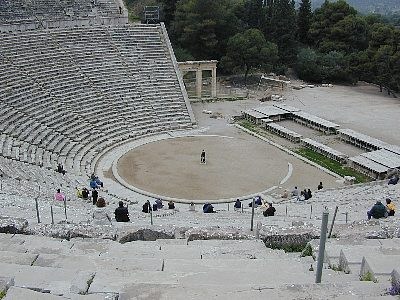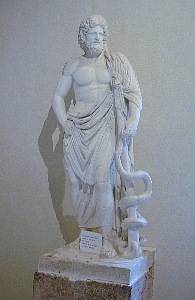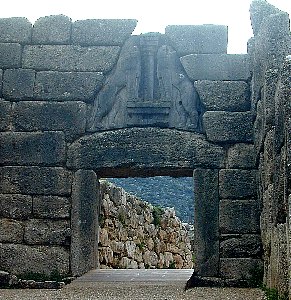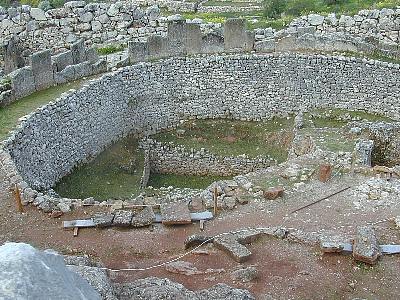Ancient
Greece
Our visit to ancient
Greece began in
Athens. The Parthenon on top
of the Acropolis is visible from much of the city. All you
need
to do is find an unobstructed vantage point, though the narrow streets
can make that difficult. Our hotel wasn't far away and we
could
see it out the bedroom window of our suite.
More views of it.
The restoration work was
interesting
in itself and gave us a chance to see some of the features close up.
From the top of the
Acropolis we
could see the part of the hill where
the early Athenian citizens met to discuss the affairs of the
day. We also saw the Erechtheum with
its porch of the maidens. And looking down from it we could see the
theater of Dioceses which had seats for 15,000 spectators.
As we walked around
Athens we were
constantly amazed to turn a corner and find that we were again looking
at history.
This Roman Bath, along a major city street, was discovered during
excavation for a ventilation shaft for the subway. Upon
discovery
construction was stopped and the shaft was relocated.
A visit to the subway is a history lesson as well. The
station at
Syntagma Square holds these and many other artifacts. Some,
like
this aqueduct from 2500 years ago, are displayed as though they were
just uncovered.
Elsewhere around the
city we saw
evidence of the Turkish period and the Tower of the Winds which was
designed by the astronomer Andronikos
of
Kyrrhos. It
served as a
sundial, and weather observatory and held a complicated water clock.
The
Folk Art Museum was an unexpected find and held some interesting works.
The lead flask would have been used to hold raki, a strong alcoholic
beverage.
Our
travels took us on to Delphi on the slopes of mount Parnasus.
There I touched the Sacred Stone that marks the navel of the
world.
According to legend Zeus released two eagles, one from the East, and
one from the West, and where they met, he threw this stone to mark the
center of the world. The second picture is the stone where the Oracle
of Delphi sat when she made her prophecy. This stone was
originally part of the floor of an underground room in the main
temple. The triangle of holes were where the base the tripod
upon
which she rested. Water from the sacred spring flowed through
the
grove and
gases from deep underground came through the hole and (along with
laurel leaves she would chew) helped her go into a trance so she could
utter her prophecies. Visitors would bring gifts to her so
that
she would favor them with her view of their future.
One famous prophecy was
given to
Croesus of Lydia (circa 546 BCE) who
asked if he should invade Persia. Her reply was that if he did invade a
mighty
empire would be destroyed. Croesus thought this meant he would be
victorious and invaded leading to the fall of his own empire.
Clearly her prophecy could be interpreted more than one way.
While we were there a
rainbow
appeared that seemed to end in the Treasury of Athens, one of the gifts
to the Oracle.
We took this as a good omen and hurried down to it but the rainbow
vanished before we got there and we didn't find any gold.
Gifts were in all sizes
and
types. Here is another picture of Treasury of Athens which
was
one of the
largest but there were many alcoves along the road to the Oracle's
temple that held statues and other offerings.
The next stop was
Athena's
temple. There again we saw a rainbow,
stronger than the last and this time it was double.
Athena is the goddess of
wisdom so I
am really looking forward to this treasure.
On to Olympia.
This model shows
the temples of Zeus (at the
center) and Hera (to the left). The other buildings were
mostly
where the dignitaries stayed and the athletes prepared themselves as
well as a few more temples to various gods. The brown
rectangle
at the top was where the games were actually held.
This is the oldest of
the religious
sites we saw there. It is just in
front of the temple of Zeus and predates it by many hundreds of years
according to our guide.
It is where the gods
Gaea (earth) and
Uranus (sky) were worshiped.
The first picture is of
area the
Olympic flame is lighted every 4
years. The bases of a few of the columns of the Temple of
Zeus
are on the left. A shrine honoring Athena is to the
right
and the gravel area and stones in the foreground are where the ceremony
is held. The second picture shows a little more of
Zeus's
temple and the three columns in the background honor Apollo.
We
seem to have
visited at the peak of the spring flowers. They were
everywhere
among the ruins. When you walk through the gate in the last
picture you are following the footsteps of the Greek athletes onto the
original Olympic field. We had a chance to compete
there.
Unfortunately we couldn't bring home a laurel wreath.
These helmets (one
Persian, one
Greek) were found here. The
markings indicate that they were those of opposing generals who met in
battle on this site.
The
tiny sculptures aren't toys but offerings to the gods brought by
visitors as are the other statues. The last one in this set
is of
Apollo with baby Dionysus.
Epidaurus, where a
competition of
another sort was held. Here individuals and groups presented
plays, musical performances, poetry and other performing arts. The
theater would seat about 12,000 and would often be filled.
This
was even more remarkable since it was remote from the major cities of
the day. Like the Olympics these were a time for people from
the
cities of Greece to put aside their differences and challenge the
others in a peaceful rivalry. The theater is still used for
both
ancient and modern works. It is famed for its
acoustics.
Our guide demonstrated by standing at the center of the stage and
talking in a normal voice which we could hear more than 50 meters (164
ft.) away. She then tore paper and dropped coins on the stone
at
the center of the orchestra (stage). Not only could these be
heard but you could distinguish the large and small coins.

The museum nearby held
this statue
of Asclepius the god of healing. In ancient times
this was
the place to come for medical treatment. This was given not
just
by offerings and prayer at the Sanctuary of Asclepius but they also
knew some of what was needed to maintain health. Hygieia, one
of Asclepius's daughters, was the goddess of health,
cleanliness
and sanitation. Panaceia was another of his daughters.

Mycenae was occupied
from neolithic
times, at least 8000 years ago. Its peak was during the bronze age more
than 3000 years ago. The first picture shows the Lions Gate.
The
heads of the lions are missing but the size and workmanship are a
testimony to the skills of these people. The blocks of stone
are
so big that they are known as the Cyclopean wall. Ancient
Greeks
thought these were so large that the builders must have had help from
the mythical one eyed giant Cyclops to erect them. The lintel
over the entrance is estimated to weigh more than 200 tons.
Heinrich Schliemann was convinced that Homer's epics were based in fact
and set out to prove it. In an incredible stroke of luck his
first excavation looking for Mycenae revealed the grave
circle.
The treasures it contained convinced him that it was the graves of
Agamemnon, Cassandra, Eurymedon and their companions. Later
discoveries demonstrated that these graves were too old by several
hundred years but they gave the impetus for further excavation.


These
pictures will give you
some idea of what was there. In addition beads, pottery, clay
figures and tablets and other artifacts were found.
It is hard to visualize
the size of
the "Treasury" at Atreus from a picture but I hope that you can get
some idea. It is a buried stone structure shaped like an old
fashioned beehive. The second picture was taken from the
inside
looking up at the triangular opening over the door. You can
see
the size of the stone blocks that were used and how accurately they fit
together.
This
monument was erected to commemorate the battle of Marathon
Are these
toys? Well the first
one is but despite the resemblance to Legos the second is stonework
that originally decorated the soffits of a temple.
Some more pictures from
our
trip to Greece and Turkey.
Click on these links
for
Modern
Greece, Ancient Greece, the Greek
Islands, our Greek
Eclipse, Greek
Eclipse Attire, Greek
Flowers, and Turkey.
See
other places we have visited here.
Go
to our Personal
home page
Go to our Community
page
Go
to our Science
Fun page
E-mail Nancy
and
Alan

